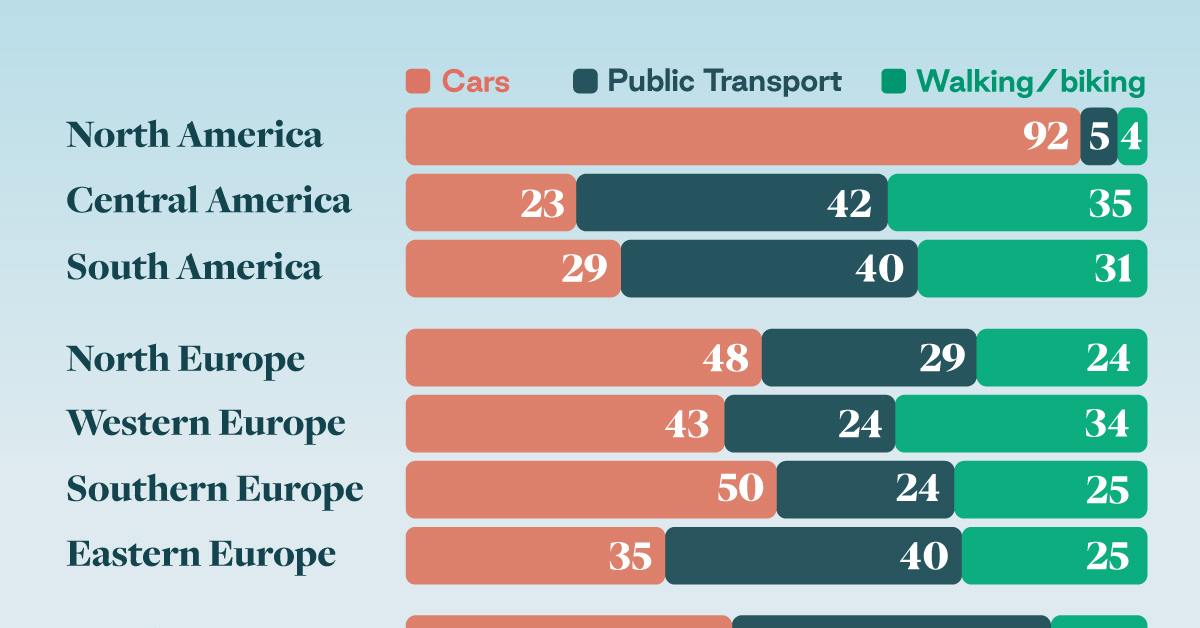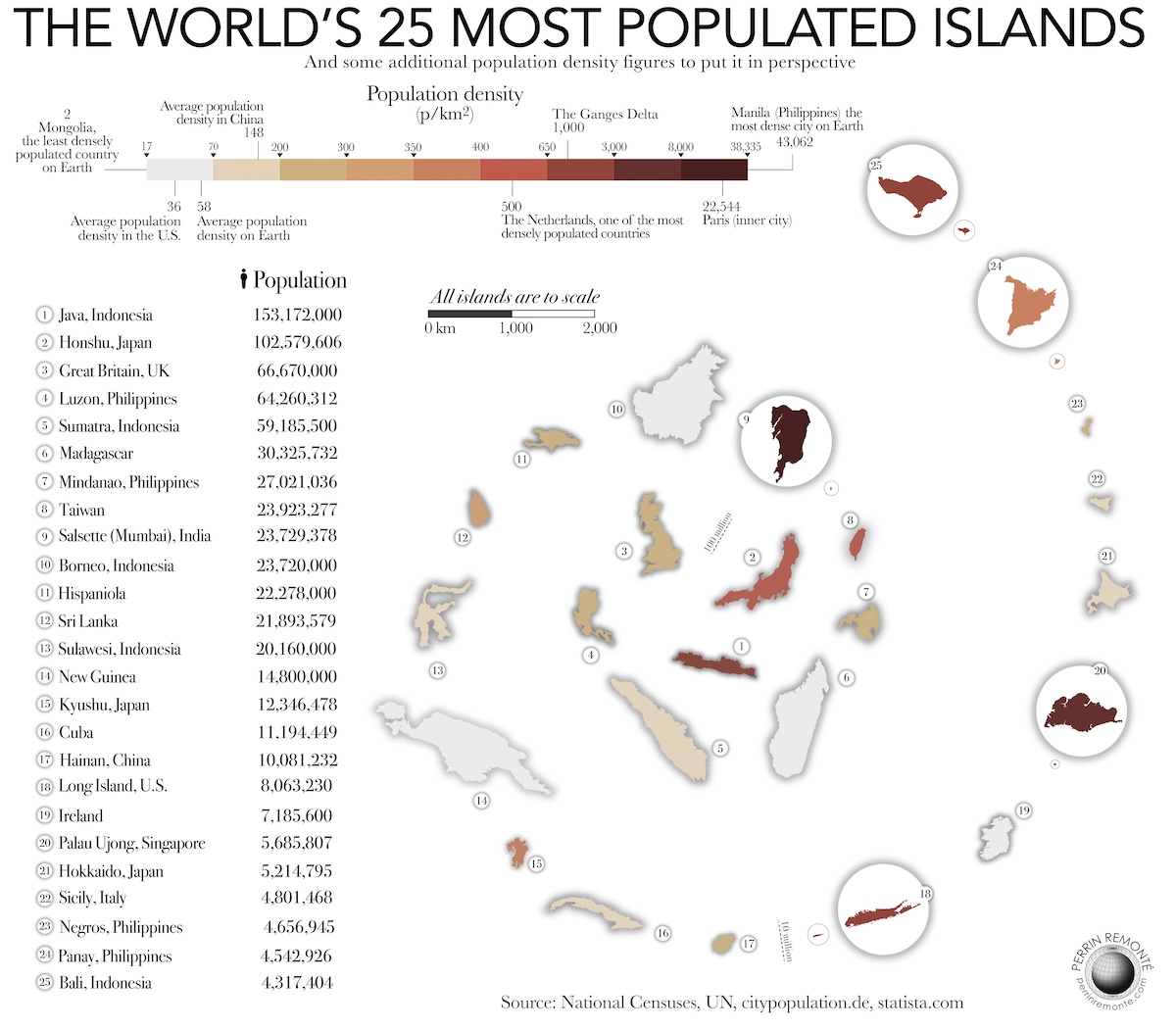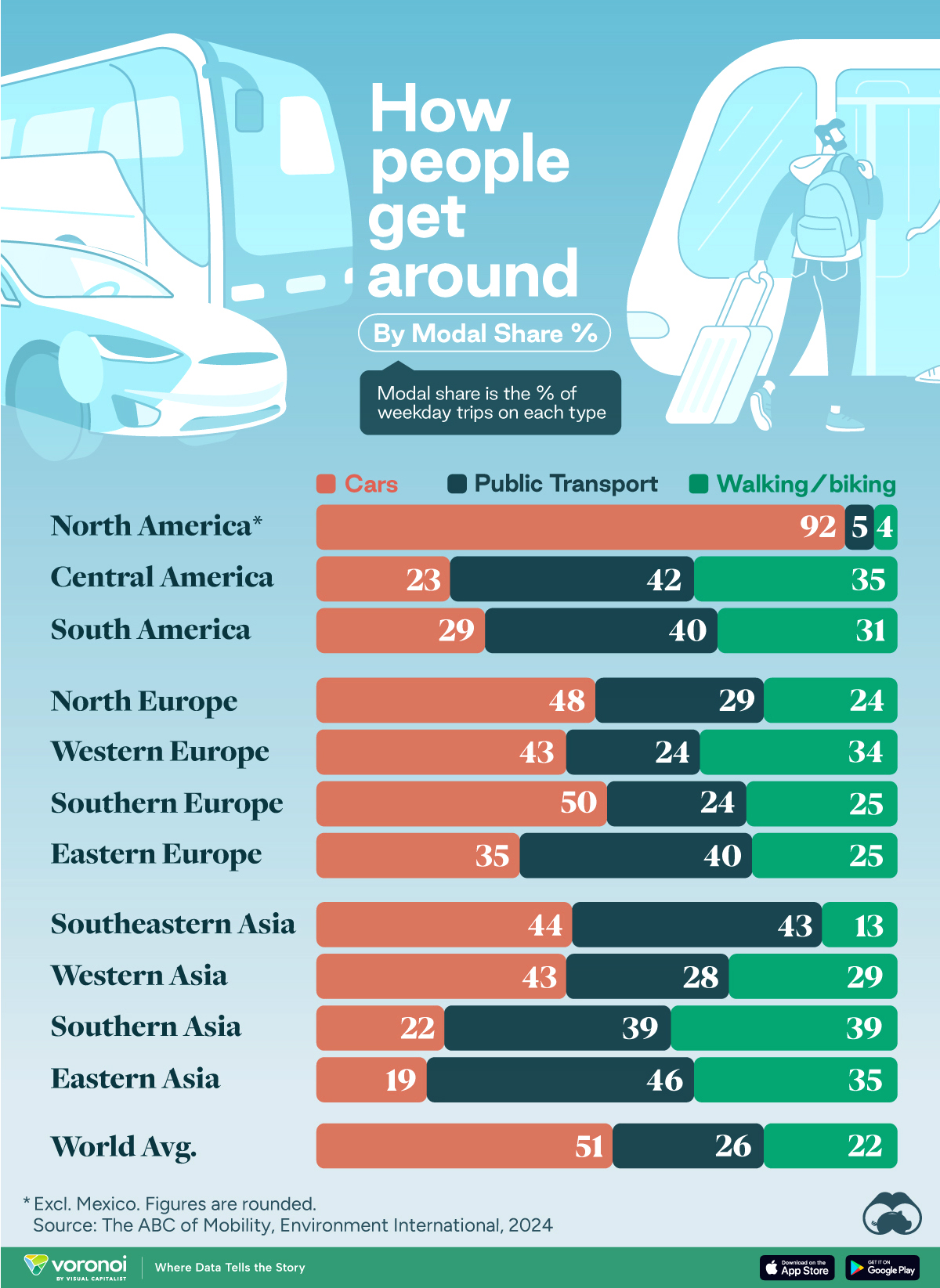Travel
What are the World’s Most Populated Islands?
![]() See this visualization first on the Voronoi app.
See this visualization first on the Voronoi app.
What are the World’s Most Populated Islands?
This was originally posted on our Voronoi app. Download the app for free on iOS or Android and discover incredible data-driven charts from a variety of trusted sources.
The word “island” tends to bring up images of remote paradise—a brisk sea breeze, waving palms, and inviting beaches, all ingredients for an idyllic life.
However, they can also be hubs for human activity, home to 730 million people, or about 9% of the world’s population.
This chart, by creator Perrin Remonté, ranks the 25 most populated islands in the world, colored by their population density patterns, along with an overview of their size relative to each other. Data for this graphic comes from a variety of sources listed at the end of this article.
Ranked: Top 25 Islands by Population
At the top of the list sits Java, Indonesia’s most populous island and the most populous island on Earth. Over 150 million residents inhabit the 130,000 km² landmass, resulting in a density of nearly 1,200 people/km².
Its capital, Jakarta—also the capital of Indonesia—is a vibrant metropolis teeming with skyscrapers, bustling streets, and a rich tapestry of traditions.
Even historically, the island has been the political and economic center of the region: the seat of empires and also the heart of the Indonesian independence movement.
| Rank | Island | Population | Area | Average Density |
|---|---|---|---|---|
| 1 | 🇮🇩 Java, Indonesia | 153M | 130K km2 | 1,177/km2 |
| 2 | 🇯🇵 Honshu, Japan | 103M | 228K km2 | 452/km2 |
| 3 | 🇬🇧 Great Britain, UK | 67M | 209K km2 | 321/km2 |
| 4 | 🇵🇭 Luzon, Philippines | 64M | 105K km2 | 480/km2 |
| 5 | 🇮🇩 Sumatra, Indonesia | 59M | 443K km2 | 133/km2 |
| 6 | 🇲🇬 Madagascar | 30M | 592K km2 | 51/km2 |
| 7 | 🇵🇭 Mindanao, Philippines | 27M | 95K km2 | 284/km2 |
| 8 | 🇹🇼 Taiwan | 24M | 36K km2 | 666/km2 |
| 9 | 🇮🇳 Salsette, India (Mumbai) | 24M | 619 km2 | 38,772/km2 |
| 10 | 🇮🇩 🇲🇾 🇧🇳 Borneo, Indonesia, Malaysia, Brunei | 24M | 751K km2 | 32/km2 |
| 11 | 🇭🇹🇩🇴 Hispaniola, Haiti & Dominican Republic | 22M | 76K km2 | 289/km2 |
| 12 | 🇱🇰 Sri Lanka | 22M | 66K km2 | 333/km2 |
| 13 | 🇮🇩 Sulawesi, Indonesia | 20M | 181K km2 | 110/km2 |
| 14 | 🇮🇩🇵🇬 New Guinea, Indonesia & Papua New Guinea | 15M | 821K km2 | 18/km2 |
| 15 | 🇯🇵 Kyushu, Japan | 12M | 37K km2 | 324/km2 |
| 16 | 🇨🇺 Cuba | 11M | 105K km2 | 105/km2 |
| 17 | 🇨🇳 Hainan, China | 10M | 34K km2 | 294/km2 |
| 18 | 🇺🇸 Long Island, U.S. | 8M | 4K km2 | 2,000/km2 |
| 19 | 🇮🇪 🇬🇧 Ireland, Ireland & UK | 7M | 84K km2 | 83/km2 |
| 20 | 🇸🇬 Singapore Island, Singapore | 6M | 704 km2 | 8,523/km2 |
| 21 | 🇯🇵 Hokkaido, Japan | 5M | 78K km2 | 64/km2 |
| 22 | 🇮🇹 Sicily, Italy | 5M | 26K km2 | 192/km2 |
| 23 | 🇵🇭 Negros, Philippines | 5M | 13K km2 | 385/km2 |
| 24 | 🇵🇭 Panay, Philippines | 5M | 12K km2 | 417/km2 |
| 25 | 🇮🇩 Bali, Indonesia | 4M | 6K km2 | 667/km2 |
Note: Numbers are rounded. Area source: Encyclopaedia Britannica. Population source: See bottom of the article.
Meanwhile, Japan’s Honshu Island ranks second, home to approximately 103 million people. Honshu is the largest and most populous island in Japan, housing iconic cities like Osaka, Kyoto, and Tokyo—the country’s capital, the world’s largest urban area, and one of the three biggest financial centers in Asia.
At third place, Great Britain, the largest of the British Isles, boasts of around 67 million residents, of which England alone accounts for 83% of the population.
Back in Southeast Asia, the island of Luzon, with 64 million people, is home to more than half of the Philippines’ total population.
Coming back to Indonesia, parts of Sumatra, population 59 million, are more along the lines of a postcard picture, from the lush rainforests of Bukit Lawang to the pristine shores of Lake Toba.
In total, Indonesia has six islands on this graphic, with tourist favorite Bali—consistently one of the most popular places to visit—coming in at the 25th spot.
Missing from this list is Australia, home to nearly 30 million people, which would make the top five on this list, were it not for the continent-island debate.
Most Densely Populated Islands
For Salsette Island (ranked 9th by population)—administratively known as Greater Mumbai —magnification is required as it appears as a dot on the scale for the other most populated islands in the world.
Consequently it’s one of the most densely populated islands in the world; at more than 30,000 people/km².
Singapore (ranked 20th), is similarly dense, though not quite at the scale as Mumbai: 8,500 people/km².
Other extremely populated and dense islands in the world include: Manhattan, Haizhu, Guangzhou, and Lagos Island, but none with the total population close to Singapore or Mumbai.
Where Does This Data Come From?
Population sources:
- Citypopulation.de (New Guinea, Sicily, Hainan, Salsette, Singapore).
- Central Statistics Office (Ireland).
- IMF (Hispaniola).
- Philippine Statistics Authority (Luzon, Mindanao, Negros, Panay).
- Statista (Great Britain, Java, Sumatra, Sulawesi, Bali).
- Statistics Bureau of Japan, (Honshu, Hokkaido, Kyushu).
- U.S. Census (Long Island).
- UN (Cuba, Madagascar, Sri Lanka, Taiwan).
Creator Note: For Great Britain and the Indonesian islands, the population figures are reverse engineered from the total population of the country and the percentage share of each island, available on Statista.

This article was published as a part of Visual Capitalist's Creator Program, which features data-driven visuals from some of our favorite Creators around the world.
Automotive
How People Get Around in America, Europe, and Asia
Examining how people get around using cars, public transit, and walking or biking, and the regional differences in usage.

How People Get Around in America, Europe, and Asia
This was originally posted on our Voronoi app. Download the app for free on iOS or Android and discover incredible data-driven charts from a variety of trusted sources.
This chart highlights the popularity of different transportation types in the Americas, Europe, and Asia, calculated by modal share.
Data for this article and visualization is sourced from ‘The ABC of Mobility’, a research paper by Rafael Prieto-Curiel (Complexity Science Hub) and Juan P. Ospina (EAFIT University), accessed through ScienceDirect.
The authors gathered their modal share data through travel surveys, which focused on the primary mode of transportation a person employs for each weekday trip. Information from 800 cities across 61 countries was collected for this study.
North American Car Culture Contrasts with the Rest of the World
In the U.S. and Canada, people heavily rely on cars to get around, no matter the size of the city. There are a few exceptions of course, such as New York, Toronto, and smaller college towns across the United States.
| Region | 🚗 Cars | 🚌 Public Transport | 🚶 Walking/Biking |
|---|---|---|---|
| North America* | 92% | 5% | 4% |
| Central America | 23% | 42% | 35% |
| South America | 29% | 40% | 31% |
| Northern Europe | 48% | 29% | 24% |
| Western Europe | 43% | 24% | 34% |
| Southern Europe | 50% | 24% | 25% |
| Eastern Europe | 35% | 40% | 25% |
| Southeastern Asia | 44% | 43% | 13% |
| Western Asia | 43% | 28% | 29% |
| Southern Asia | 22% | 39% | 39% |
| Eastern Asia | 19% | 46% | 35% |
| World | 51% | 26% | 22% |
Note: *Excluding Mexico. Percentages are rounded.
As a result, North America’s share of public transport and active mobility (walking and biking) is the lowest amongst all surveyed regions by a significant amount.
On the other hand, public transport reigns supreme in South and Central America as well as Southern and Eastern Asia. It ties with cars in Southeastern Asia, and is eclipsed by cars in Western Asia.
As outlined in the paper, Europe sees more city-level differences in transport popularity.
For example, Utrecht, Netherlands prefers walking and biking. People in Paris and London like using their extensive transit systems. And in Manchester and Rome, roughly two out of three journeys are by car.
-

 Personal Finance1 week ago
Personal Finance1 week agoVisualizing the Tax Burden of Every U.S. State
-

 Misc7 days ago
Misc7 days agoVisualized: Aircraft Carriers by Country
-

 Culture7 days ago
Culture7 days agoHow Popular Snack Brand Logos Have Changed
-

 Mining1 week ago
Mining1 week agoVisualizing Copper Production by Country in 2023
-

 Politics1 week ago
Politics1 week agoCharted: How Americans Feel About Federal Government Agencies
-

 Healthcare1 week ago
Healthcare1 week agoWhich Countries Have the Highest Infant Mortality Rates?
-

 Demographics1 week ago
Demographics1 week agoMapped: U.S. Immigrants by Region
-

 Economy1 week ago
Economy1 week agoMapped: Southeast Asia’s GDP Per Capita, by Country













